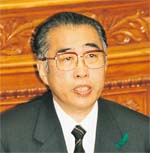Japanese Government
Page 1 | Page 2


The main entrance and central tower of the Diet building (left). Built in 1936, it is located in Nagatacho, central Tokyo. The late prime minister Obuchi Keizo (right, 1937-2000) was once described as being like 'cold pizza'. But the bland politician, who served from 1998 until his untimely death from a stroke, enjoyed surprising poularity even among young people. In the election held shortly after Obuchi's death, his vacant seat was contested and won by his 26-year old daughter, Yuko. This kind of inherited political power is very prevalent in Japan.
Japan's Political System
The Kokkai (Diet) is divided into the Sangi-in (lower chamber or House of Councillors) whose members serve a six-year term - half of the members are elected every three years - and the Shugi-in (upper chamber or House of Representatives) whose members are elected to a four-year term. The Sangi-in has 247 members, 149 members in multi-seat constituencies and 98 by proportional representation.The Shugi-in has 480 members, 300 members in single-seat constituencies and 180 members by proportional representation in 11 regional blocs.
Executive power is vested solely in the naikaku (cabinet), which consists of the sori daijin (prime minister) and not more than 15 daijin (ministers of state) and is collectively responsible to the Diet. This means that, when requested, they must attend sessions of both houses and their committees to answer questions on government policy. Question Time, a feature of the British parliament, was recently introduced to the Diet.
The prime minister has the power to appoint and dismiss the ministers of state, a majority of whom must also be members of the Diet (non-Diet members are rare). Ministerial posts are usually divided up between the different factions or coalition partners in an effort to keep everybody happy. In an effort to curb militarism, the constitution includes the requirement that all ministers must be civilians. Following legislative elections, the leader of the majority party or leader of a majority coalition in the House of Representatives usually becomes prime minister. In the case of the dominant LDP, the party president was routinely chosen. Recently, with the many factions within the party, the choice of prime minister has often been the result of a lot of behind-the-scenes power-broking.
Until recent years, the government framework was made up of the Prime Minister's Office, 12 ministeries and 10 agencies. The system was revised in January 2001 in an attempt to increase efficiency and strengthen political control over decision making. Under the revised system, the structure now consists of the Cabinet Office, 10 ministries and 2 agencies. The ministries are: Justice; Foreign Affairs; Finance (Japanese name changed from Okurasho to Zaimusho ); Education, Science and Technology; Health, Labour and Welfare; Agriculture, Forestry and Fisheries; Economy, Trade and Industry; Construction and Transport; Public Management, Home Affairs, Posts and Telecommunications (whew!); and Environment (upgraded from an agency).
If the House of Representatives passes a resolution of nonconfidence or rejects a resolution of confidence in the Government, the cabinet must resign unless the House of Representatives is dissolved within 10 days.
The highest judicial body is the Supreme Court. The chief justice is appointed by the emperor after designation by the cabinet and all other justices are appointed by the cabinet.
Regional Administration
Japan is divided into 47 prefectures, and local administration is conducted at the levels of prefectural, city, town, and village governments, each with their respective assemblies. The prefectural governors and city, town, and village mayors, as well as the members of the local assemblies, are elected by the voters registered to be residing in the particular district. Local governments employ over 3 million people, including about a million teachers and quarter of a million police officers.
Some regional leaders enjoy national recognition, particularly when they enter politics from the entertainemnt business. Famous recent examples include:
- Ishihara Shintaro, governor of Tokyo. A famous author, he is the brother of the legendary actor Ishihara Yujiro. Often cited as the man many people think should have been prime minister, he never pursued his ambitions all the way. Read his profile.
- Higashikokubaru Hideo, governor of Miyazaki. A former comedian with something of a reputation as a playboy, he proved surprisingly effective as governor of a relatively obscure part of the country. He made good use of his high profile to bring media attention and business to his voters.
- Hashimoto Toru, governor of Osaka. A successful family lawyer and famously the father of seven children, he was a popular and outspoken figure on the variety show circuit. He was elected governor on a platform of youthful energy and reform.
Page 1 | Page 2
Related content:
Links
Official Government websites:
- Prime Minister's Official Residence
- House of Representatives
- House of Councillors
- Supreme Court
- National Diet Library
- National Archives of Japan
- Cabinet Office
- Ministry of Justice
- Ministry of Foreign Affairs
- Ministry of Defense
- Ministry of Finance
- Ministry of Education, Culture, Sports, Science and Technology
- Ministry of Health, Labour and Welfare
- Ministry of Agriculture, Forestries and Fisheries
- Ministry of Economy, Trade and Industry
- Ministry of Land, Infrastructure and Transport
- Ministry of Public Management, Home Affairs, Posts and Telecommunications
- Ministry of the Environment
- National Public Safety Commission (Japanese only)
- National Police Agency
